













Watauga River
Home of world class fishing on the beautiful Watauga Lake, rugged Doe River and designated trophy trout stream, Watauga River PLAN


Watauga Lake
Doe River



















Watauga River
Home of world class fishing on the beautiful Watauga Lake, rugged Doe River and designated trophy trout stream, Watauga River PLAN


Watauga Lake
Doe River




Thevery best hunting knives possess a perfect balance of form and function. They’re carefully constructed from fine materials, but also have that little something extra to connect the owner with nature. If you’re on the hunt for a knife that combines impeccable craftsmanship with a sense of wonder, the $79 Huntsman Blade is the trophy you’re looking for.

The blade is full tang, meaning it doesn’t stop at the handle but extends to the length of the grip for the ultimate in strength. The blade is made from 420 surgical steel, famed for its sharpness and its resistance to corrosion.
The handle is made from genuine natural bone, and features decorative wood spacers and a hand-carved motif of two overlapping feathers— a reminder for you to respect and connect with the natural world.
This fusion of substance and style can garner a high price tag out in the marketplace. In fact, we found full tang, stainless steel blades with bone handles in excess of $2,000. Well, that won’t cut it around here. We have mastered the hunt for the best deal, and in turn pass the spoils on to our customers.
But we don’t stop there. While supplies last, we’ll include a pair of $99 8x21 power compact binoculars and a genuine leather sheath FREE when you purchase the Huntsman Blade
Your satisfaction is 100% guaranteed. Feel the knife in your hands, wear it on your hip, inspect the impeccable craftsmanship. If you don’t feel like we cut you a fair deal, send it back within 30 days for a complete refund of the item price.
Limited Reserves. A deal like this won’t last long. We have only 1120 Huntsman Blades for this ad only. Don’t let this beauty slip through your fingers. Call today!
Huntsman Blade $249*

Offer Code Price Only $79 + S&P Save $170
1-800-333-2045
Your Insider Offer Code: HBK208-01
You must use the insider offer code to get our special price
Stauer ®


Stauer® 8x21 Compact Binoculars

-a $99 valuewith purchase of Huntsman Blade

What Stauer Clients Are Saying About Our Knives



“This knife is beautiful!”
— J., La Crescent, MN
“The feel of this knife is unbelievable...this is an incredibly fine instrument.”
— H., Arvada, CO
Rating of A+
14101 Southcross Drive W., Ste 155, Dept. HBK208-01 Burnsville, Minnesota 55337 www.stauer.com
*Discount is only for customers who use the offer code versus the listed original Stauer.com price.
California residents please call 1-800-333-2045 regarding Proposition 65 regulations before purchasing this product.
•12” overall length; 6 ¹⁄2” stainless steel full tang blade • Genuine bone handle with brass hand guard & bolsters • Includes genuine leather sheath
October is one of my favorite months to fish, and the dwindling traffic on the bays is just a small reason why. September may have been a record hot month for a lot of us, but the transition of the seasons is more than just the temperature for wildlife. The length of the days play a big part in the fish transitions for the season. Although October opens several new opportunities for anglers, I am going to give you an insight as to how I plan to catch them.
The marsh should be full of life and hold an
abundant amount of the big three: trout, redfish and flounder. It will not be uncommon to find all three in the same location gorging themselves on last spring’s hatch of shrimp and finfish. I will predominantly throw smaller soft plastics in the 3.25-inch size. I like a durable lure because the action can be fast and furious, and I don’t want to waste time changing out lures after one or two fish and miss my opportunity for more. I lean toward paddletails because I can work them faster, cover more water, and the added
vibration will draw strikes since these fish will be aggressive. The cover type and water depth will determine if I rig them weedless or on a jig head. Either method is acceptable, just adapt to the structure.

I prefer to fish outgoing tides in these areas. Generally, an outgoing tide produces a better bite and concentrates fish in smaller areas where I can target them. These pinch points can be mouths of drains, bayous, pinch points within a bayou or a bend. Those are the more obvious ones, but don’t overlook points extending into a bay or cuts through a reef. The points of islands or reefs can also increase the flow of current congregating the fish in an area.
Here are some retrieves I like to use for each of these three species in October. Keep in mind none of the fish read this article, so you will catch others on these retrieves. In general, reds will hit a lure on a steady retrieve, trout like the erratic twitch-twitch, and flounder react well to my lure darting along the bottom. When darting my lure along the bottom, I hold my rod tip down or sideways to the water and give it firm twitches. I make sure to keep my lure on the bottom and not bouncing it up and down like I would for trout. I want to disturb the bottom to get their attention.
As we all know, all fish will eat any retrieve, but if you are not catching the species you want, try a different action before you change the lure. Enjoy the cooler weather and take a kid fishing, I know I will do both!

Capt. Michael Okruhlik is the inventor of Knockin Tail Lures®, and the owner of www.MyCoastOutdoors.com.

































































Five marvels of engineering that earned their stripes smashing fish in lakes and rivers, supertuned by Berkley® scientists to conquer the salt and its fiercest inhabitants. Action, vibration, casting distance, hook-up ratios – every aspect has been optimized to your advantage. All built for battle with virtually bombproof bodies and hardware, featuring ultra-sharp, anti-rust Fusion19™ 3X Hooks for ultimate endurance. Over 80 sizes and colors to choose from.

The presence of life was obvious long before we reached the jetty. On an outgoing tide, dingy water rushed through the channel cut from the bay to the ocean. It flushed with a brown plume that carried the detritus of marsh decay.
Diving birds were the first sign we were in the right place at the right time. As we got closer, other anglers came into view. There were a couple of boats jockeying for position off the end of the jetty, another trolled the rip farther offshore, and the beach brigade was set up fishing that corner pocket where current flowing down the shore piled up against the rocks.
Pods of pogies flickered and darted, harassed by gulls from above and by redfish, trout, small sharks and who knows what else from below. Blue crabs skittered around doing cleanup duty just outside a light surf.
With all this life, catching fish shouldn’t be a problem, right? Well, if you talk to any veteran of
By Nick Carterthe rocks, they’ll tell you putting in the time to learn a particular jetty is the key to success. Every jetty has its own peculiarities, its best times and tides, its hidden holes and mixing currents.

Here are a few tips to help flatten the learning curve at a new jetty.
1) Start in the Rocks: The food chain of a jetty is created by the stuff pushed against the rocks. The rocks also create current breaks and hidey holes where predators lay in ambush for baitfish, shrimp and crabs that feed on the buildup of organic matter. Start your search close to the rocks. Work quickly but meticulously to pick a jetty apart. You can’t see everything that’s going on under the surface, but with experience, the sweet spots will become evident.
2) Make Friends with the Old Guy: In the scenario above, it was our first time to this jetty, and we went straight in with a cast net to scoop up pogies. It seemed obvious to match the hatch, and we caught some fish… mostly stingrays
and catfish. As we clambered all over the jetty in search of the magic combination of factors to produce a more exciting catch, an old man posted up in a beach chair came tight with an enormous bull red. After helping him land the fish and jawing with him a while, he gave up a secret. He’d been fishing the jetty for years, and big reds and tarpon at this spot are suckers for half a fresh blue crab fished on the bottom. Because jetties draw anglers as well as fish, being friendly or just watching can lead to solid local knowledge.
3) Find the Current Seams: Fish where fast and slack current meet. Predators hang in the slack and wait as a conveyer belt of food is swept past them. Conversely, baitfish also seek refuge and stack up where there is current shade. Either situation makes these areas high probability targets for anglers.
For more fishing tips, go to coastalanglermag.com.

 PHOTO CREDIT: WAYNE CROSS
PHOTO CREDIT: DON SHETTERLY
PHOTO CREDIT: SHANE TROTTIER
PHOTO CREDIT: WAYNE CROSS
PHOTO CREDIT: DON SHETTERLY
PHOTO CREDIT: SHANE TROTTIER
A283-pound alligator gar caught at Sam Rayburn Lake in Texas is set to break a 72-year-old IGFA alltackle world record. Here’s the kicker: It was landed with 6-pound-test line!
Kentucky angler Art Weston teamed up with Texas Capt. Kirk Kirkland on Sept. 2, in search of lineclass records. Weston is an IGFA record breaker who already has numerous lineclass records for alligator gar and other species. It was the first day of a week-long booking aboard Capt. Kirkland’s The Garfish Enterprise, and they hooked and landed what Kirkland called “the Holy Grail of the fishing world.”
Sam Rayburn Lake is the largest reservoir in Texas at 114,000 acres. It’s an impoundment of the Angelina River near the Louisiana border north of Jasper, Texas. According to a report on FoxWeather.com, Kirkland told Weston of an area on the lake with a sandy, snag-free bottom that would suit light line tactics well. The guide also told Weston there might not be many fish in the area, but they were obviously going for quality over quantity.
Before the pending world record showed up on the scene, the pair caught two other monster alligator gar, including a 169-pounder. When they came tight with the

largest alligator gar caught in nearly three-quarters of a century, it took about three hours, remarkable skill and more than a little bit of luck to land the fish on such light line.
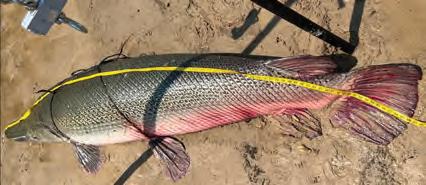
“Lots of blood, sweat and tears (and broken line) went into this achievement,” Kirkland wrote on Facebook. “Angler and world record Chaser Art Weston and I did what no other alligator gar angler has been able to accomplish in 72 years.... catch a fish bigger than the all-tackle world record set so many years ago on the bank of the Rio Grande River.”
The existing all-tackle world record weighed 279 pounds. It was caught by Bill Valverde from the Rio Grande in 1951.

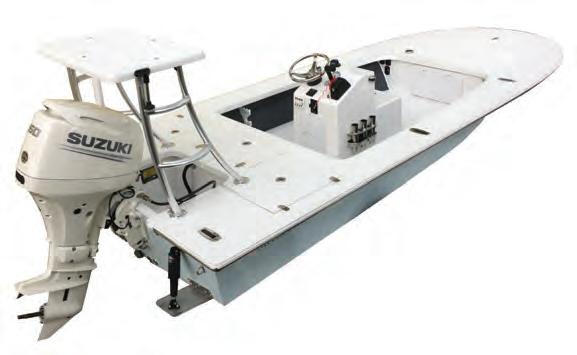

“We both had a look of shock when the scale just kept going higher and higher,” Kirkland said. The gar weighed 283 pounds on camera. It measured 100 inches long, with a 48-inch girth. After taking measurements, the giant fish was released alive.
To read the entire FoxWeather report, go to https://www.foxweather.com/lifestyle/world-recordalligator-gar-texas-sam-rayburn-lake





Performance Bulletin Available
59 YEARS OF REPOWER EXPERIENCE!
Mastry Engine Center has received the Suzuki Marine Super Service Award and has been ranked #1 in Suzuki Marine US Sales!
Repower packages designed to best fit your needs and not stretch your budget. Financing available.





All Suzuki repowers come with the new Suzuki 5-year factory warranty.
Many of our Suzuki RePower Centers feature Water Accessible Drop Travel Lifts.

Suzuki RePower Centers are stationed around the southeast to help with your Suzuki service and repower needs.

Emily Hanzlik shows one of her more recent records, a 23-pound longnose gar caught on 8-pound test.

area? Living in Florida, I knew bow n were available to me, so that’s where I started. On the IGFA website, you can search speci c species and see the current records for di erent categories. Here you’ll see the all-tackle, alltackle length, conventional female and male, y male and female, junior male and female, and smallfry categories.
For the junior category, you must be 16 or younger. However, if you are a junior you can submit a record for the adult category. All-tackle length is a newer division that requires a special measuring device from the IGFA, so keep that in mind if you want to try for a length record.
Read the rules regarding the category you are shing for. I cannot stress this enough. Many simple mistakes happen, and it is not worth having a record rejected. e rules are in the record book and on the website. IGFA rules can be complicated and include restrictions on things like the lengths of leaders. Your record quest will be much less frustrating if you know the rules and sh accordingly.
Let’s discuss tools you’ll need to record records. I prefer the Rapala Mini 50-lb. scale, which needs to be certi ed. e easiest way to certify your scale is to ship it to IGFA. ey will certify it for you.
Some people sh for the meat, in tournaments, or simply for fun. I take a di erent approach. I seek out world records.
e International Game Fish Association (IGFA) keeps track of every record ever caught on rod and reel. I’ve been tracking down these records for more than six years, and here’s a little insight into the process.


First, you need a starting place. What species can you target in your
Most IGFA records are line-class records, which means you’ll o en be shing light lines, and the line must be approved by IGFA, meaning it breaks at the speci c pound test. I like Ande tournament line because it breaks at the correct poundage.
Once all your ducks are in a row, you can target the sh you’ve planned for. is is going to take a lot of time and patience, but eventually putting in time pays o . When you eventually catch a sh that looks big enough to break the current record, there are steps you must take. For the all-tackle length record, you need a photo of the sh on the IGFA measuring device and a photo of the angler with the sh and rod. For the other records, you need photos of the girth, length, weight, and the sh and angler.
e main thing to remember is to have patience and enjoy the process. Breaking records isn’t easy, so just keep trying!
Emily Rose Hanzlik holds over 60 IGFA world records in various categories. She hails from West Palm Beach, where she has a part time Bow n Guide Service as well as shing classes for Jr. Anglers. Find her @emilyhanzlikoutdoors.
$158.05














Divers put a hurting on invasive lion sh on Sept. 8 and 9 at the 14th annual REEF Florida Keys Lion sh Derby. A record 1,898 lion sh were collected, and a single team set another tournament record by bringing 648 of the nasty critters back to the docks.
Team Forever Young, led by Capt. Tony Young, of Forever Young Spear shing, really put in the work and won the “Most Lion sh” division of the tourney. With team members Jason Vogan, Billy Moscatello and Luke Rankin, this is the third time Forever Young has set a new tournament record for total catch.
Overall, 22 teams of divers competed at the event, and $7,000 in cash and prizes were awarded to teams that brought in the most, largest and smallest lion sh. e “Most Lion sh” category included the competitive Apex Predators division and the Reef Defenders division for casual lion sh hunters. Forever Young obviously won the Apex Predators division. Volitans nished second with 291 lion sh, and Team Trash placed third with 101 lion sh.
In the Reef Defenders division, Men of Science won rst place with 156 lion sh. Sea Venom Creations brought in 128 lion sh for second place, Barnacles won third place with 121 lion sh.

Competition was close in the largest and smallest lion sh categories. Barnacles won rst place in the “Largest Lion sh” category with a 16.85inch lion sh. Men of Science’s second place sh measured 16.57 inches, and Forever Young took third with a 16.34-inch sh.
e smallest sh of the derby was 2.36 inches and was collected live by ZooKeeper. Team Will 2 Spear won second place with a 2.83-incher, and Tequila Little Time brought in a 2.99-inch sh, also live, to take third. e two live lion sh will be part of an educational exhibit at the REEF Campus.
In case you been under a rock, lion sh are native to the Indo-Paci c and are highly invasive and detrimental to native marine life on our coasts. Events like REEF’s derbies are held all along the Florida coast to both raise awareness of the problem and to cut down on lion sh numbers.
“Lion sh derbies show how a community can come together to support ocean conservation while combating invasive species. It’s so exciting that our teams set a new Florida Keys record of 1,898 invasive lion sh removed. We are very thankful to all of the derby participants, event volunteers, and everyone who attended and helped make the Florida Keys Lion sh Derby & Festival such a great success,” said Alli Candelmo, Ph.D., REEF Conservation Science Manager.
For more information about REEF Lion sh Derbies, visit www.REEF.org/lion sh-derbies.























Trade-in your dirty, uncivilized, oil-burner for an environmentally responsible, clean, quiet, efficient Suzuki 4-stroke!

For a limited time, when you purchase a new Suzuki outboard from an authorized Mastry RePower Center you will receive a Special Trade Allowance for your dirty and outdated 2-stroke outboard. This is Mastry’ s commitment to help keep our waterways clean as well as making it easier for you to improve your boating experience with an up-to-date quiet, efficient 4-stroke outboard. Contact your closest Mastry RePower Center for the details of this Exclusive Mastry RePower Center Offer.











Fishing for charitable causes has become a growing venue for bringing together our love of the sport and helping those in need.
e duality of empowerment and peace that shing brings helps people who have struggled. From easing post-traumatic stress disorder, recovering from physical trauma, mental and social disorders, to helping troubled youths nd redirection, shing can easily be classi ed as therapeutic. No matter what cause is important to you, there is likely a shing tournament dedicated to it.
Fishing tournaments have been put together by donations solely to get certain groups on the water to participate, such as events for veterans and

pediatric cancer patients. ese events create incredible opportunities for people who truly need them, and they are a great way to donate and help share the therapeutic power of shing.
e other style of charitable shing tournaments are ones you can participate in yourself, and proudly take a minor hit on your winning payout, knowing you are donating to a good cause. While the rst type is extremely sel ess and noble, let’s face it, everybody needs a little shing therapy in their life. O en, the shing tournaments where you participate provide opportunities to people a ected by the cause, and you will be joined by the people you are there helping, as well. is is easily one of the best excuses to sh, and way more fun than simply signing a check.
In honor of breast cancer awareness month, the ladies of the world would like to o cially turn your attention to the boobies. at’s right, you’re invited to look.
Breast cancer a ects one in eight women. Although this type of cancer is rare in men, it has a higher mortality rate due to late detection, and that is a part of the awareness this month is dedicated to.
ankfully, with advancements in awareness and detection, survivability of this diagnosis has increased exponentially. Many survivors turn to shing for recovery, both physically and emotionally.
If you nd yourself in Pompano Beach Oct. 5-7, e Pink Ladies Breast Cancer Foundation invites you to sh their multi-species, 2nd Annual Cureament shing tournament. Founder, and cancer survivor, Carolyn Stash, has put together a non-pro t tournament for breast cancer awareness and fundraising for a cure. She has worked her ta-tas o to attract sponsors and has put together exciting prizes and ra e items for this year’s tournament. Among the list is a one-of-a-kind, pink, 9-foot Reef Runner, with a trailer and a 9hp motor, and shing charters, including one from yours truly, at Sweet E’nuf Charters out of Marathon, Florida Keys.

Fish alongside erce breast cancer survivors and their dedicated supporters. If you miss this year, mark your calendars for next year. Contact Carolyn Stash at (954) 465-3743 and visit their website at www.pinkladiesbreastcancerfoundation.org to get involved.

Call Capt. Quinlyn Haddon, of Sweet E’nuf Charters, Marathon, Florida Keys at (504) 920-6342.






















A900-pound, 13-foot-long alligator caught on Aug. 25 might be the second largest gator in Florida history, and it’s by far the largest gator we’ve heard about so far this alligator season.

Capt. Kevin Brotz, of Get Bit Outdoors, guided clients Carson Gore and Darren Field to the giant gator on an Orlando area lake, according to Outdoor Life. It took close to four hours to subdue the beast.
“Honestly, my rst concern was safety, because we were in a smaller boat, and then you add a gator whose head is this big,” Brotz said as he spread his arms wide in a CNN video interview. “All he has to do is turn, and we’re in trouble.”

“I laid down in the front of the boat and said I have to lay down until we get back,” Gore told CNN. “I thought I was going to die. at thing was huge.” At one point during the battle, the gator leapt 3 or 4 feet out of the water right next to the boat. Brotz told Outdoor Life it was like being eye-to-eye with a T-Rex.




e statewide alligator season runs Aug. 15- Nov. 1. Hunters are required to apply for and obtain a limited entry permits each season. For information go to MyFWC.com.
Watch video of the team ghting the gator on Field & Stream’s YouTube channel.
As you may know if you are a frequent reader of page 1, Cary and I live in Dixie County on the river, about an hour southwest of Keaton Beach, where Idalia made land fall. On our three properties in Dixie County, we have lots of trees. We have a few fewer now, and the standing trees have fewer branches. My Confederate Rose trees got beat up, but we had no structural damage to any of our buildings. We were without electricity for five days, but thankfully, we have a generator for the essentials (but that didn’t include A/C or my kitchen lights). Many, many people had it much worse. We are so very grateful for the emergency response crews who worked long hours until power was restored to every home and business. As our coastal towns, Crystal River, Cedar Key, Suwannee, Horseshoe, Steinhatchee and Keaton Beach re-open, they will be very happy to see you and grateful for your business.


I couldn’t get seafood from Kelly this month for the recipe because they were temporarily closed, so this month’s recipe is an encore performance. It is one of our favorites. See page 2 for Shrimp and Wild Rice Skillet over Spinach. By the time you read this, I am sure that Kelly’s is open.
As I write this evening, Cary and I are traveling in our 1991Buick hearse to Cookeville, TN, to join like-minded vintage Buick owners for our annual fall get together, we call “tours”. For four days, we will drive our beautiful cars around the Cookeville area, taking in the sights, enjoying culinary offerings and and enjoying each other’s company. Last year, Cary and I hosted in the Gainesville area, visiting Alachua, Marion, Dixie and Levy Counties.
Please, please remember to thank our advertisers and the generous folks at our pickup locations. Without them and our writers, you would not be reading the world’s greatest FREE fishing magazine.
The two flower photos on this page are the same flower, a Confederate Rose. It opens white in the morning and turns pink at the end of the day.

Stay smart, stay well, stay alive. Get that new Covid vaccine when you get your annual flu shot!




Happy Halloween!

 Lynn Crutchfield Co-Publisher Coastal Angler Magazine of North Central Florida/Nature Coast
Lynn Crutchfield Co-Publisher Coastal Angler Magazine of North Central Florida/Nature Coast


GRAPHIC

Kathleen Stemley
CONTRIBUTING
Noel Kuhn
Dr. Kevin McCarthy
Capt. Jason Clark
Capt. Katie Jo Davis
Capt. Tommy Derringer
Capt. Andrew Fagan
Capt. Jonathan Hamilton
Capt. Tony Johns
Capt. James Kerr
Capt. Pat McGriff
Capt. Brent Woodward
Photo by: Suwannee River Water Management District
• ½ cup wild rice
• ½ cup white or brown rice
Into large bowl, pour 4 cups water, add salt and brown sugar. Stir to combine. Add shrimp.
Cook white or brown rice in broth or water and cook wild rice in water. When rice is cooked, drain shrimp and pat dry with paper towels.
Heat oil in large skillet. Add shrimp and cook 1 to 2 minutes on each side. Remove shrimp from skillet and keep warm.
• 1 cup chicken broth or water
• 1 cup plus 4 cups water
• 2 tablespoons Brown Sugar
• 2 tablespoons salt
• 1 pound shrimp, peeled and deveined

• 2 tablespoons extra virgin olive oil
• 2 tablespoons butter
• 4 green onions chopped
• 2 cloves garlic minced
• 2 bags fresh spinach
• 4 slices cooked bacon
• salt and pepper
• Parmesan shaved
• ½ lemon (Optional)
Add butter and green onion to skillet and cook until tender, 1 to 2 minutes. Add garlic and cook 30 seconds. Add spinach and cook, (turning several times) until wilted. Add bacon and rice. Add salt and pepper to taste and gently combine.
Plate, and top with cooked shrimp and shaved Parmesan. Serve with lemon wedges.
Lynn Crutchfield, Co-Publisher Coastal Angler Magazine of North Central Florida

beautiful Kings Bay while you enjoy your delicious, freshly prepared meal, watching manatees, dolphins, pelicans and boats. Or, you can carry it home; your choice. Open Tues-Thurs 10:00-5:30, FriSat 10:00-8:00. 201 NW 5th St. Crystal River 352-795-4700.Thank you to The Crab Plant for the shrimp. Visit their Fresh Seafood Market or enjoy Cooked Seafood to go. You are welcome to sit at their table and view


One of the riverine turtles that boaters may come upon in our North Florida rivers is the Suwannee cooter (Pseudemys concinna suwanniensis). Originally described in 1937 by one of the state’s premier turtle scientists, Dr. Archie Carr of the University of Florida, the large turtle is found in many rivers that drain into the Gulf of Mexico. Interviews with residents of North Florida communities, especially around Cedar Key, indicate that humans have been capturing and eating the turtle from early in the twentieth century.
By Kevin McCarthyThe turtles usually have a black upper shell, the carapace, and some of the scutes, the thick horny bony plate on the shell, may have straight or curvy yellow lines. The head may also have a yellow line. Adults can have a carapace that is 17 inches long.



The Florida Fish and Wildlife Conservation Commission (FFWCC) has listed the species as one of “Special Concern,” and one that may eventually be listed as “threatened.” For many years wildlife biologists and law-enforcement officers mistakenly thought that limiting the taking of those turtles to two per individual would not cause a decline in their numbers, but that is no longer the case.


The slow-moving turtles are particularly susceptible to boat strikes, when boaters who are not on the look-out for turtles may run over them and do serious damage to the animals’ shell. Scientists studying the distribution of the turtles in the early 2010s, found a large number of them at Gilchrist Blue Springs Park, possibly because a hurricane and heavy rains depleted the underwater aquatic vegetation that the turtles relied on. Most of the subspecies of turtle are found in North Florida rivers, including the Ochlocknee and Suwannee,
but scientists have found some of the animals as far south as the Alafia River near Tampa. One of the favorite areas for these gentle creatures is springs, leading into the Suwannee and Santa Fe. For example, scientists discovered a large group of juvenile cooters in Fanning Spring, indicating that the spring there may be like a nursery area.
The mostly freshwater turtles seem to be most at home in the rivers of the Florida Panhandle where they can find the desired underwater vegetation and above-water sites for basking. They thrive on native aquatic plants and algae. The fact that
the cooters seem to like to eat invasive species of aquatic plants is a good thing for conservationists trying to control or eliminate the invasive plants.
They are great to photograph and wave to, but don’t pick them up or move them to another site. Leaving them alone will help them have more baby turtles. Dr. Kevin
site: kevinmccarthy.us
“Fair winds and following seas" - best wishes from a traveler
Whew, what a hot summer we had, and I know I cannot be the only one looking for some cooler days out on the water. Fall fishing is always a great time on Florida’s Nature Coast and I look forward to it every year!


One thing you can expect to catch are redfish in abundance, as they are continued to be schooled while heading to the mouth of the creeks, all while staging themselves for the upcoming winter months. Mud minnows on a 1/16-ounce jig, with a small float keeping them above the rocky points, is a great bait of choice.
The sea trout also begin to move into the shallower waters along shallow grass flats and always enjoy a shrimp jigged along the bottom.
Snook season remains open through October into November, and they are found in much larger numbers inshore. A DOA glow jerk bait on a 1/16-ounce jig, cast far across an oyster bar with strong current, produces a fast-moving bait for the reaction bite.

Gag grouper will continue to move in shallower as well, which produces excellent opportunities for the shallow water casting plug


action.
Regardless of what type of fish you want to catch, October is always a fun month with a cooler time on the water.


















Hey anglers, I want to start by saying thank you to all who have come to the big bend area and helped, and are still helping with cleanup. Hurricane Idalia was devastating to so many of us, and the support from the surrounding communities has been absolutely amazing!
Now, on to fishing. We are up and running full time charters again and the fish seemed to miss us. Every trip this week has been double digit redfish, with one day,


catching over 130 fish! The schools of reds have taken over Cedar Key and we are loving it. All you need is a little bit of cut bait (I've been using finger mullet.) and you will be golden. Look for areas along the keys that are loaded with bait and you shouldn't have a problem finding reds.


The same also goes for trout and snook. The trout have loaded the flats again and the ole trusty popping cork and paddle tail combo has been killing it in 3 to 5 feet of water.

With all the new debris stuck out there, the snook have made new homes. All those trees that are now on the flats, have turned into perfect places to send a jerk bait, and land those fun fish!
So come on out to Cedar Key, book a trip, and support as many of these small businesses as you can. We will all forever appreciate it! Until next month, stay safe out there! Capt. Jason Clark




Hey everybody. I have to be honest, the last couple of weeks have been pretty tough!
Hurricane Idalia swept through the Big Bed Region of Florida, bringing record level flooding that hasn't been seen in over 100 years! At my place, I had five to seven feet of water in my yard, with three feet in my home. Things are drying out while we are cleaning up, fixing up and rebuilding. It takes a special breed to call this area home!

Let's talk about some fishing! If you had asked me 20 years ago to name the best month to come fishing in Suwannee, without hesitation I would have said October! Now, I have to say that November has been coming on strong the last few years, as patterns seem to be changing.

As the days have been getting shorter, the speckled trout have finished up their annual spawning season. Now, they will be focusing on food, as they fatten up for the coming winter months. Knowing this, we need to focus on areas that will hold plenty of forage for the predators! The nearshore and offshore grass flats had been holding some nice fish just before the storm.
As you venture out. be prepared for changes. Hurricane Idalia moved islands, shifted sandbars and filled in channels! You will find that some of your best areas won't produce like they used to! Don't get frustrated! Now's the time for exploring and finding the "new hot spots"! The spot that was really good 10 or 15 years ago might be the new hot spot.
Now is when you really need to utilize your eyes in the sky; the birds will know where the fish are! This works offshore, nearshore
and inshore. Now we all notice the pelicans and many times they can be on "good fish", but for me I have more success focusing on the smaller white birds. The terns or lookdown birds seem to be on "good fish" more often than not.
If you are a Big Bend Backcountry angler, then you will find many changes! Bars at the mouths of the creeks will have shifted or maybe even be completely gone! In many areas you will find new cuts along the shoreline, areas where the force of the water was too strong for the banks! Also, there will be lots of debris, especially the further you venture into the backcountry. These new cuts and debris, like trees laying in the water, provide new ambush points for the predator fish, especially the snook! While I am exploring, looking for those new spots, I like to throw the FishBites Fight Club 5-inch Jerkbait. Either a ⅛ or ¼ ounce jig head or if I want to go weedless, then a 1/16 or ⅛ ounce weighted hook is the way to go. Until next time, be safe, Tightlines and Catchemup!
Captain Tony Johns | 352-221-2510

www.lowersuwanneriverfishing.com
Instagram: captaintonyjohns Facebook: Lower Suwannee River Fishing Adventures










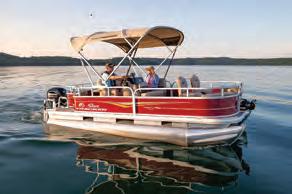











Drivers must be at least 16 years old with a valid driver’s license to operate. All riders should always wear helmets, eye protection and footwear. Never drink and ride.




As things start to (hopefully) cool off a bit, the mullet will be thick throughout our NE Florida waters. Our fall mullet run is one of the best times of year to get outdoors and do some fishing. Cooler air temperatures and hungry predatory fish means fun for everyone on the water. The best areas to fish will be easy to find right now -- where you see the mullet, you’ll find redfish, trout, flounder, snook, and maybe even a few tarpon. Those fish will be lurking just underneath the mullet schools looking for an easy snack. There are countless numbers of lures, both hard and soft plastic, that do a great job of imitating a mullet. This is probably my favorite month to go the top-water plug route and use a Berkley J-Walker 100 or 120. They are great “walk the dog” type plugs that even the most shy redfish or trout can’t resist this time year. If you want to go subsurface, try the soft plastics from Saltwater Assassin like the 4 inch Sea Shad. It looks just a like a mullet and can be fished weedless, or on a traditional jighead.
Along with the influx of mullet to Northeast Florida, comes our fall flounder run. Some of the best catches, both in numbers and in size, come in the fall. The fish-finder rig is the go-to for many anglers, looking to catch some flounder. It consists of using about 12 inch or so of leader, attached to a swivel with
a barrel weight above the swivel. You want to use enough weight to hold the bottom, and a hook, sized accordingly to the size of mullet or minnow you’re using. Another favorite rig is a jighead in either 1/4 or 3/8 oz. with a finger mullet pinned to it. The jighead rig allows you to fish without getting hung up as easily on structure like oysters and rocks. If lures are your thing, try a Saltwater Assassin Jerkbait or paddle tail, rigged just like you would the live stuff.
The inlets will come alive this month. Big bull redfish will be schooling, in the deeper areas of all the inlets, as well as on the edges of the St. Johns River. A cut blue crab or mullet on the bottom, will get their attention. There will also be some tarpon around the inlets, feeding on the bigger mullet schools, so make sure to have a bigger rod ready to go for these monsters.
If you missed out on the flood tides last month don't worry, you still have plenty of days in October to find some tailers. Redfish and sheepshead will still be tailing away looking for crabs, snails, and just about anything that hangs out in the grass. Any crab or shrimp soft plastic imitation will work well for the reds.
Capt. Tommy Derringer
www.InshoreAdventures.net
904-377-3734
October is my favorite month!
Why? The air temps are dropping. The surf temperature is dropping. The Mullet Run is still coming. Tarpon are still here. Pompano are coming back from their summer vacation in North Carolina. On top of all that, the fish of many species have started feeding in the surf! Whether you like chunking a top water popper, free lining a live mullet or soaking a sand flea, it is go time!
If you choose to fish live mullet for redfish, tarpon, trout, jacks, etc., and use mono leader, be prepared to lose some tackle! The big blacktip sharks are thick this month. On my last outing, I lost three new sputnik sinkers and three 50-pound mono double dropper rigs. If you want a good fight with these strong fighting sharks, use 175-pound stranded wire leader, finished off with a 7/0 circle hook.
I love targeting redfish when the mullet are running. The tackle is simple. A fishfinder, slip sinker, or Carolina rig with 30 lb. mono leader is perfect. Hook size depends on the size of the mullet. The smaller the hook, the longer they stay lively. I use 1/0 up to 7/0 for big foot long baits.
Keeping your bait frisky when it is warm can be challenging. You need to keep them aerated, cool and breathing clean water. Instead of just a five-gallon bucket, I use a five or ten-gallon round Igloo cooler. A short handled dip net, keeps your oily sun-blocked hand from contaminating the water. After all that, I still add fresh sea water as often as possible. Frisky baits equal more strikes!
The black drum, whiting and pompano will be readily munching on sand fleas and ghost shrimp. A double dropper rig with 2/0 circle hooks works the best. Concentrate your efforts on deep troughs and run-outs for more success!

Now through mid-November, is the Northeast Florida's best time to surf fish! So go now, and go often, before cold water pushes the fish offshore or down south. Until next month, tight lines, or I will see you on the beach!
 Noel Kuhn
Noel Kuhn
43 years of surf fishing experience, surf fishing guide and long distance casting coach. Founding member of Florida Surf Casters club. 904-945-0660
www.TheSurfAngler.com
Hello here from Crystal River, hopefully everyone is out fishing and enjoying the water.
The bite is great, as we get closer to cooler weather. This is my favorite time of year to fish, especially when the water temps start to drop and cool down.
The trout bite is starting to pick up on the inside waters. Lately, I’ve been using popping corks with 1/16 oz jig, tipped with a Little Jon. Color choice depends on the water clarity for me. I look for areas that have bait and good spotty hard bottom.
Redfish are pretty much everywhere. I’ll start most days just looking for mullet. Usually, I don’t even have a specific spot that I’m going to fish. I just look for mullet. The very beginning of the incoming or the outgoing tides are always the best. Live baits are always a good choice along with some cut bait. Artificial is a good choice also. Mirrordines and DOA Jerkbaits work great.
Snook are doing well. Look for good moving water and areas that you know hold snook. A little tip, make long casts and use a good live bait. Also, if you see them, it’s usually too late. Spend the time to scout for them and learn where they frequent.

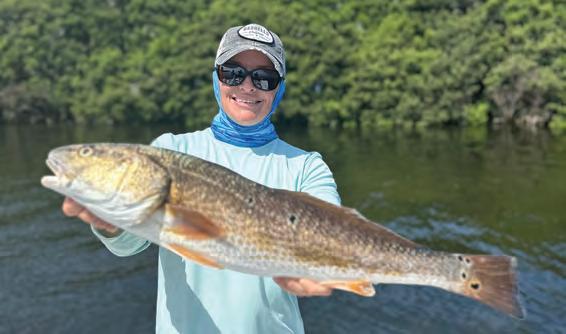
I have open days available give me a call to get out on the water and come stay a night or two at the Plantation here in Crystal River.
Until next month
Capt. James Kerr
352-362-6893
Citrusfishingchaters.com
Ilove October fishing in the Homosassa region. It’s one of my favorite months, hands down. The days are shorter, and the water temperatures are falling. With the dropping water temps, we will see great fishing on the Nature Coast. Trout will start heading inshore, the inshore grouper game will fire up and the red fishing will be on!
Redfishing can still be really good this month. With redfish still pushing north, we still may have some decent sized migrating schools that are north bound. Most of these fish can be over sized, so get a quick picture and quickly get them back into the water. Look for these schools to float in with incoming tides around the outside points or keys. Also, look for jumping mullet. My favorite way to catch these fish this time of the year is on a ¼-ounce gold spoon. If you’re throwing bait, shrimp rigged on a 1/16th ounce DOA jig head, or a free lined pin fish can produce. Fly fishing for red fish this month can be super successful as well. You need to be there when these fish are floating in and throw shrimp pattern flies or gurglers.
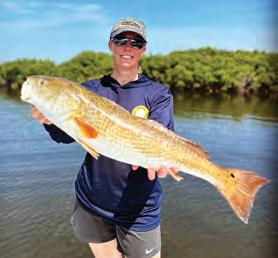


For trout, look for yellow bottom from Trout Key Bay, outside St. Martin Keys and all the way down to Chassahowitzka point. These fish are coming in from offshore, and they like noise! Fish will respond well to a DOA popping
cork followed with 20 to 24 inch of fluorocarbon to a 1/16 ounce jig head, rigged with a Mirror Lure little John in glow or watermelon red flake. The secret to fishing the cork rig is to give it time in the pause, two to three seconds at least. The jig needs to fall down to their zone.
Fish for snook on the outside points with good water flow. DOA 5.5 CAL in glow nose hooked with a 3/0 J hook, or a free lined pin fish, will get the job done. As the water cools, these fish will move to the east.
Near shore rocks will be producing a plethora of groceries for your dinner table. Expect to catch plenty of decent sized mangrove snapper, grunts and mackerel. Shrimp on a jig head will keep the rods bent. Great fun for the kids! Grouper will also be moving into the 8-to-15-foot range. Casting or trolling plugs will produce some nice fish. Live pin fish or cut threadfins will also make them bite. On your way back in, make sure to check floating debris, piling, and buoys for triple tail. Shrimp under a cork work the best! As always, Stay safe.
-Stump Capt. Jonathan HamiltonInshore/Offshore is the theme this week, and it’s short and sweet, so we’re gonna keep it simple. Fantastic inshore fishing right now. The redfish are spawning in massive numbers on all of the western most points, and it’s not uncommon to go through 100 live baits before lunch if you encounter them. On the artificial side, a gulp in a jig head or a ¾ oz. gold spoon works wonders as well. The tripletail bite remains good with many fish over ten pounds still in the mix, and a few over 15. A live shrimp on a short leader and a small float, is the ticket!




Offshore/Nearshore, the gag grouper bite is excellent in 12 to 25 feet of water, casting big swimbaits and plugs over the rocks. If you prefer the east method, a live well full of pinfish, and a lightly weighted pinfish will get the job done as well.

Tightlines everyone!
Capt. Andrew Fagan Instagram : Capt_redfishdrew EBB TIDE CHARTERS









Hello everyone, Hope everybody is having a good month. Fishing is incredible after the hurricane! I’m gonna talk a little bit about damage control. A lot of us have tremendously slowed down since the storm. Unfortunately, cancelations come with this type of thing and we’ve seen our share.
What can you do? Instead of canceling, try to find a different place to stay. We have power and water at this point, or just stay a short drive inland. The quicker we can get money back into town, the quicker things will get back to normal.

I also want to say that the community love I’ve seen has been incredibly generous. This place is getting cleaned up at a record speed, but things like this take time unfortunately.
I foresee the fishing doing nothing
but getting better than it is already, with temperatures starting to dip. If you want to get out on the water, give us a call. Also, duck season is around the corner, so go ahead and book a duck trip for your family.
Until next time, keep it Reel Native!
 Captain Brent Woodard Reel Native Fishing Charters ReelNativeFishing.com
Captain Brent Woodard Reel Native Fishing Charters ReelNativeFishing.com


352-284-5514



Let’s grow with Florida together.












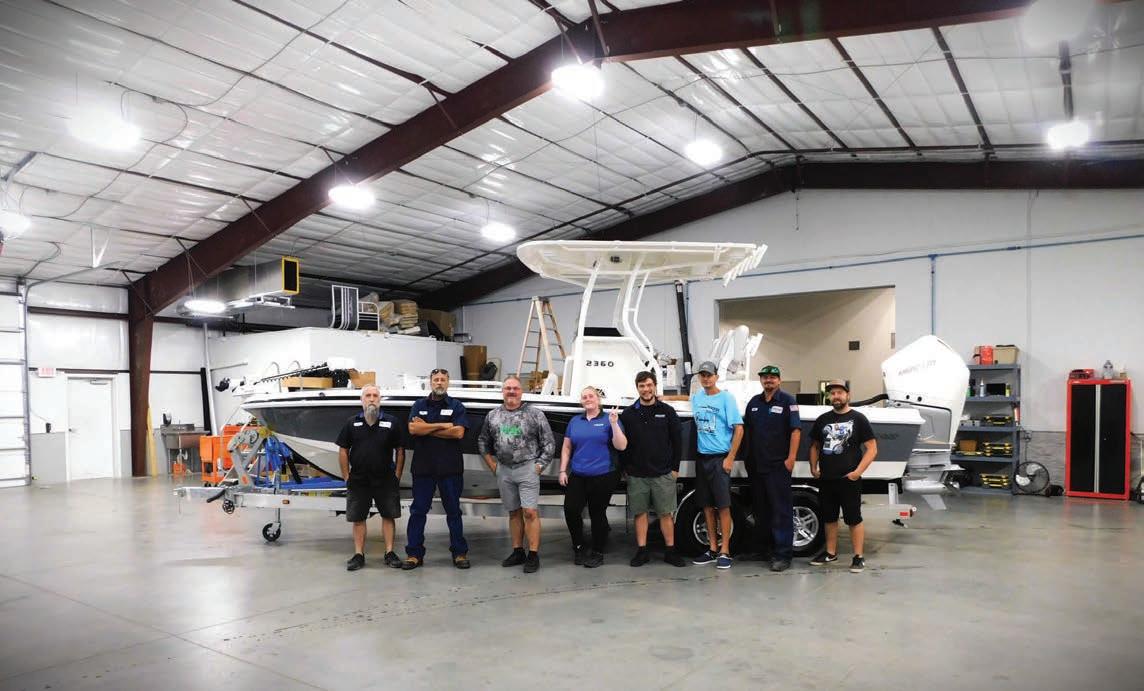













 By Coty Perry
By Coty Perry

Although kayak anglers use the same lures as bank and boat anglers, we o en must adjust our approach. One lure I’ve found myself using di erently while bass shing from a kayak is the crankbait. I love throwing a crankbait, but a challenge to shing one in a kayak is the drag created by the lure. Fishing kayaks are much lighter than bass boats, so your kayak moves toward the lure as you retrieve it. Learning to control the yak was a signi cant adjustment I made when
transitioning to shing a crankbait from a kayak. I now steer my yak while reeling a crankbait instead of picking up a paddle. All I do is point my rod tip in the opposite direction I want to go. When my rod tip points to the le , my kayak dri s to the right and vice versa. To go straight, I point my rod tip straight ahead.
Speaking of the rod, I use a shorter rod, mainly because I sh areas with a lot of overhanging trees, and shorter rods transport easier in my rod box on my trailer and kayak. I also use a higher-speed reel than bank and bass boat anglers because I’m losing speed as the kayak dri s towards my crankbait. So, instead of a 6:1, I use an 8:1 or 7:1 gear ratio.
I spool up with braided line and use a 3- to 5-foot, 12- to 17-pound test uorocarbon leader. e length and strength depend on water clarity and how deep I sh.
More than likely, I have a squarebill crankbait tied on while shing shallow, which is a majority of the time. However, I will tie a deep-diving crankbait during the summer.
Where to Fish a Crankbait in a Yak
Crankbaits have a lot of bene ts, but they also have limitations. A lipless crankbait can be shed in the grass, especially along the edge of the grass, but most of the time, I sh crankbaits along rocky or riprap banks and over the tops of brushpiles.
I want my lure hitting every rock on the retrieve back because this o en triggers a bite. e same holds true for shing around laydowns and brushpiles. I don’t want to get snagged, but I’ve gotten so many bites a er bumping into submerged limbs.
Fishing in these two areas has helped me catch loads of bass on a crankbait, plus a few cat sh.
When to Fish a Crankbait in a Kayak
I sh a crankbait year-round. However, I change the style. In the cooler months, I tend to break out a lipless crankbait the most. As the water warms, I switch to a squarebill, and once I’m sure the sh have moved to deeper water, I’ll tie on a deep-diving crankbait during the hottest times of the year.
Coty Perry is a third-generation angler, who has a lot of experience on the water and loves sharing what he knows on anglers.com.



With so many species closed to harvest, releasing sh properly is more important than ever as we need these sh to thrive and spawn. ere are some very simple rules to follow that will help ensure the vitality of a released sh.
First and foremost, keep them wet. A sh out of water is going through a major amount of stress. is is especially true a er a long ght. It’s like running a race and then having to hold your breath. e best-case scenario is to use a dehooker that allows you to release the sh without ever taking it out of the water. Long pliers or dehookers that slide down the line and allow you to ip the sh o work great. If you do need to li the sh, work fast and get the sh back in the water before it stops dripping water. When taking pictures, keep the sh in the water until you are completely ready. Also consider a more creative angle other than the traditional hero pose so the sh stays in the water. e way you handle the sh out of water makes a huge di erence. Keeping them wet also preserves the vital slime on the sh which is crucial. Make sure your hands are wet. Avoid putting sh on dry surfaces. Rough dry surfaces like boat decks and rocks remove much of the vital slime from a sh. Never use a dry towel to handle a sh; that can be the kiss of death. Using a rubber net versus a nylon net also greatly reduces the amount of slime removed.

Bottom shing in deep water creates another issue, barotrauma, or the expansion of gas inside a sh as it ascends from the deep. You know the bulging stomach and eyes. Descending devices are easy ways to ensure sh su ering barotrauma make it safely back to the bottom. ey are required by law now in many areas for many species. While venting tools work well, most people do not use them properly and o en don’t have the proper tool. Ice picks are not proper devices.

Lip clamps and inverted hook style release techniques are simple and work great. Here’s a bonus: if you visit Return ‘Em Right (https://returnemright. org), you can get the equipment you need for free. It’s a $100 value.


Have a rod rigged and ready with your descending device so you get the sh back in the water and down as quickly as possible. I’ve also found that the using a lighter weight than provided by Return ‘Em Right is much easier to retrieve and works on smaller snapper and such. at said, with many grouper out of season, make sure you keep a heavier weight with you for when you get a big one.
Helping sh survive being caught today is the key to having sh to catch tomorrow.

Will Schmidt is a seasoned tournament angler who has been writing about shing from more than two decades.










Be


One of Florida’s premier bass sheries, known as Stick Marsh or Farm 13, is re lling and should become a better shery thanks to a large-scale habitat restoration conducted by FWC and the St. Johns River Water Management District.

e reservoir, which straddles Brevard and Indian River counties, was drawn down by 4 feet in February to stimulate submersed plant growth and re-establish native emergent vegetation, which should improve habitat for sh and wildlife. FWC sta planted the southern portion of the reservoir with native aquatic plants, including 131,000 bulrush and 40,000 spatterdock plants at a total cost of $400,000. Plants were installed across the waterbody going east-west to provide a natural wave break for the shallow southern end.









Two tree islands form a Critical Wildlife Area within the reservoir, which provides nesting and roosting habitat for imperiled waterbirds, including roseate spoonbills and tricolored herons. e lower water levels created by the drawdown bene ted waterbirds by increasing foraging habitat and concentrating prey. Water levels will be allowed to slowly rise with rainfall and by now should be back within the normal range.
ree Forks Conservation Area to the north also underwent a drawdown. ree Forks Reservoir will be back within normal range before Stick Marsh/ Farm 13.
e St. Johns Water Management Area boat ramp at Stick Marsh/Farm 13 and the omas O. Lawton Recreation Area boat ramp at ree Forks Conservation Area remain accessible. Be aware that shallower water continues to create underwater hazards.


For more information, visit MyFWC.com.



In the Atlantic, mature white shrimp go on the move in fall and transition to tighter fall and winter homes in the ocean.
ere are only a few sh that do not actively seek out white shrimp this time of year. For almost all the sh we seek to catch, it’s the ultimate bait.


At one point in my life, I spent an incredible amount of time cast netting and storing white shrimp (green tails) for trout shing in October, November and December. e biggest problem with shrimp as bait is all the trash bites from pin sh and all the other little snappers. Snook and tarpon will de nitely key on a big pretty shrimp, but keeping the trash o of them is di cult. Everything down there will give a shrimp a whack and at least take a few legs or the tail o is is the reason I went the arti cial route years ago when it comes to shrimp.
ere is nothing, I mean NOTHING, more e ective on inshore species than a live shrimp with a 6/0 - 8/0 circle hook under a sliding cork or freelined. With that said, I’ve taken the path of least resistance and now sh a DOA Shrimp on a jig head. It gets the bite, and I don’t spend hours messing with live bait or netting it on the morning of the trip.
I’m not saying catching live shrimp is a waste of time… it’s not, but with arti cials, I can show up with my entire tackle box in a small backpack full of tricks.
e hour or two at daylight in the morning, I prefer the “measles” color DOA because a shrimp’s legs and underbody are red in the dark and at rst light. When the sun gets up, I switch to the “near clear” color when the water is clear, but only if they stop eating the measles color. You can’t x what ain’t broke.
I mash the barb down on the jig hook. is way, when sh I don’t plan to eat come to the boat, I don’t have to touch the sh. Just grab the jig head and give a quick reverse motion. e hook comes right out. You can get back in the action, and the sh has a better chance of survival. e same jig and so plastic shrimp combo is extremely e ective shed under a xed cork at night. Make a long cast up-current around bridge pilings, docks or other structure. is is not the situation for a popping cork with all the beads and rattles. I like a nice quiet, heavy-duty cork that can be shed quietly or with quite a bit of noise. I stay in touch with the cork, and let the current dictate the speed of the retrieve. Any way you sh it, white shrimp reign supreme for inshore shing, especially in October and November.
To see more from Tim Barefoot, go to barefootcatsandtackle.com.
Florida’s extended fall Gulf of Mexico red snapper season is still going on. Gulf Anglers are taking advantage of some great shing, and there are still eight weekends in October and November to get in on the action.
e limit is two per person, per day with a 16-inch minimum size limit. e remaining 2023 dates available for harvest of red snapper in the Gulf are:
• October 6–8
• October 13–15
• October 20–22
• October 27–29
• November 3–5
• November 10–12 (Veterans DayWeekend)
• November 17–19
• November 23–26 (ThanksgivingWeekend)

Anglers pursuing red snapper in state or federal waters from a private recreational vessel, even those exempt from shing license requirements, must sign up as a State Reef Fish Angler (annual renewal required) at GoOutdoorsFlorida.com.




For more information, go to MyFWC.com.

Prospects for loading the cooler bottom shing got a little slimmer when harvest of blueline tile sh closed in Atlantic state waters of Florida on Sept. 1. is closure is consistent with the closure in adjacent federal waters. Harvest will reopen May 1, 2024.
ese delicious bottom dwellers are frequently caught by anglers targeting deep-water groupers. ey inhabit 250- to 800-foot depths and their popularity as a game sh has risen in the last decade as restrictions on other species has led anglers to target them. ey came on the radar for federal sheries managers in 2014 and 2015, when blueline tile sh were determined to be over shed.
e regular season for blueline tile sh in Atlantic state waters is May 1 through Aug. 31. e daily limit is three sh within the aggregate limit for blueline tile sh and grouper.
For more information, visit MyFWC.com.
You need a new watch…the one you are wearing was made when Nixon was in office, but extravagantly-priced watches that add zeros just because of a high falootin’ name are an insult to your logic. Why shell out big money so some foreign company can sponsor another yacht race? It’s time to put an end to such madness. It’s absolutely possible to have the highest quality, precision classic timepiece without the high and mighty price tag. Case in point: The Stauer Urban Blue
Packed with high-end watch performance and style, minus the high-end price tag. It’s everything a high-end watch should be: Sturdy stainless steel and genuine leather construction. Precision timing that’s accurate to four seconds a day––that’s more precise than a 27-jewel automatic watch priced at over $6,000. And, good looking–– with simple, clean lines and a striking metallic blue face.
“Blue watches are one of the growing style trends seen in the watch world in the past few years”––WatchTime®

Your great escape from the over-priced watch craze. At Stauer, we go directly to the source (cutting out the middleman), and engineer our own watch designs. This means we can offer a top quality timepiece that happens to only cost the same as two well-made cocktails at your favorite bar. So, while we’re busy
You
Only $29!
revolutionizing the watch industry to bring you more real value, you can take your own stand against overpriced watches with the Urban Blue.
Your satisfaction is 100% guaranteed. Wear the Urban Blue for 30 days. If you’re not convinced that you achieved excellence for less, send it back for a refund of the item price. The Urban Blue is one of our fastest sellers. It takes six months to engineer this watch so don’t wait. Take a stand against overpriced watches in impeccable style. Limited to the first 1900 responders to this ad only. Don’t miss out...call today!
Your Insider Offer Code: UBW593-02 You

would be hard pressed to find a timepiece of this outstanding quality and precision at this price.





Catching a grander is one of the most sought-after feats in sportfishing. Boats, crews and anglers enter rare air when they hook and land a 1,000-pound-plus marlin, and untold time and money are spent chasing the dream.

Fishing solo from a 22-foot boat, angler Arnold Pauro achieved his lifelong dream Aug. 25 when he hauled in a 1,128-pound blue marlin that is a new record for the Cook Islands. According to the Cook Island News, Pauro came tight with the huge blue fishing just 3 miles off the southern end of the island Rarotonga.
Rarotonga is the most populated of the Cook Islands, which is an archipelago nation out in the middle of the South Pacific northeast of New Zealand. Rarotonga is renowned for excellent flats fishing, especially for bonefish, and like many volcanic islands, the water drops into thousandfoot depths just a few miles offshore. This creates a situation where bluewater fishing is very accessible, even for anglers in smaller boats.
According to the Cook Island News, Pauro managed to subdue the giant fish solo in his small boat, Haurua, by keeping a short line. He first brought the fish boat-side after just 3 minutes, and then all hell broke loose. Arnold told the news outlet that the fish jumped 40 or 50 times and ran out of steam after about an hour and a half.
“I kept it to 50 metres of line, kept it short, I don’t like letting my marlin go,” he told the Cook Island News.

Arnold’s fish topped the Cook Island weight record of 1,045 pounds, which was set by angler Paku Poila in November 2020. The IGFA all-tackle world record for blue marlin was caught off Brazil in 1992. It weighed 1,402 pounds.

To read the original report, go to www.cookislandsnews.com.
For the third time in the last 13 years, serious flaws have been revealed in the National Oceanic and Atmospheric Administration’s (NOAA) data collection programs for recreational fisheries. A recent pilot study conducted by NOAA itself and published in August found that estimates on angler effort might be overestimated by 30 to 40 percent.

These inflated estimates are important because they are part of the equation used to manage our fisheries. The data is used in stock assessments, and to estimate harvest numbers and recreational discard. By overestimating angler effort, catch data is also inflated, which means the data erroneously reflects a larger harvest by recreational anglers than actually exists.

In a nutshell, the pilot study found that the Marine Recreational Information Program’s Fishing Effort Survey is confusing to respondents, which led to “reporting errors” and “illogical responses.” NOAA said this survey, which is mailed to licensed saltwater anglers, “remains the best and sometimes the only available science for tracking relative year-to-year and long-term effort trends.”

The immediate reaction to this revelation from some outlets was a call to reduce restrictions on recreational anglers. The estimate means fewer fish were actually caught, which means there are more fish still in the water, right? Not so fast. This catch and effort data also figures into stock assessments. The inflated effort numbers translate to an overestimation in fish populations.
“The news of this significant overestimation has serious implications for all of our fisheries. Since every species is managed differently, the ramifications of this information cannot be quantified under a singular umbrella,” reads a











report from the American Saltwater Guides Association (ASGA). “It does not mean that because fishing effort is less than originally expected, there must be more fish to harvest. In fact, it will mean there needs to be a major re-calibration because effort is used to help determine stock size. If we have overestimated effort, we also overestimated the stock. We must go species by species to understand the best path for management moving forward. Now more than ever, we need to be precautionary in our management approach.”



NOAA has indicated it will initiate further studies into the findings of its pilot study, according to the ASGA report. Meanwhile, a group of marine conservation and recreational fishing organizations has ramped up its call to wrest control of recreational data collection from the federal government and turn it over to state agencies.
“Yet another major revision to the federal recreational data collection system is upon us, and it should bring a realization that NOAA is just not capable of doing this job,” said Ted Venker, conservation director of the Coastal Conservation Association. “At best we are looking at several more years of questionable revisions, recalculations, and recalibrations based on a suspect data system that has never proven it can produce accurate information. This is no way to manage a public resource. It would be irresponsible to continue down this road rather than exploring and supporting state-based options to better manage the recreational sector wherever feasible.”


Recreational anglers in Chesapeake Bay and along the Atlantic Coast must continue to release all striped bass longer than 31 inches after fisheries managers extended an emergency regulation that was set to expire on Oct. 28. The extension’s new expiration date is Oct. 28, 2024, which gives the Atlantic States Marine Fisheries Commission (ASMFC) more than a full year to grapple with a complex management plan intended to rebuild the coastwide striper population by 2029.
The emergency measure was first implemented in May, after estimates showed recreational harvest nearly doubled in 2022 over 2021’s figures. At the time, projections plummeted from a 97 percent chance the stock would be rebuilt by 2029 to just a 15 percent.
NOAA’s Fisheries Effort Survey, which was found recently to have overestimated angler effort by 30 to 40 percent, is an important part of recreational harvest estimates. It also plays into stock assessments for the striped bass fishery.
However, scientists still believe striped bass reproduction has been down since 2015. The 2015 age class was strong, and those fish are now the larger fish in the population that contribute most to reproduction. The emergency measure was implemented to protect the larger breeding fish.
The Chesapeake Bay “Trophy” season, which has historically been an important fishery for bay anglers, is exempt from this emergency regulation. The short early May season in Maryland has allowed anglers to keep one fish longer than 35 inches per person. A press release from ASMFC warned anglers that this special season might change once the emergency measure is replaced by a management plan that is supposed to come from ASMFC’s Addendum II of the Atlantic Striped Bass Fishery Management Plan.
Addendum II is a complex document with a range of management options intended to rebuild the striped bass stock by the end of the decade. It was hoped Addendum II would be ready for implementation in October. After five hours of back and forth at an August commission meeting, the decision was made to delay action. Now, the earliest a new management plan can be implemented is January 2024.
“Moving the emergency action forward was an important stop-gap measure to balance fishing mortality in the recreational fishery,” said David Sikorski, a Maryland delegate to the ASMFC. “Unfortunately, the delay in advancing draft Addendum II leaves uncertainty in our ability to meet our rebuilding goals and reduce overall fishing mortality ahead of the 2024 fishing year. Between now and the October 2023 meeting, draft Addendum II will be updated and provided to the board and posted online.”
The 31-inch maximum emergency rule will remain in place until Oct. 28, 2024, or until it is replaced by restrictions in Addendum II.
For more information, go to http://www.asmfc.org/


Snelling a hook is an age-old way of attaching it to your line. It is a technique that pre-dates the invention of hook eyes, when hooks only had flattened tops and snelling the hook was required to create a good connection to the line.
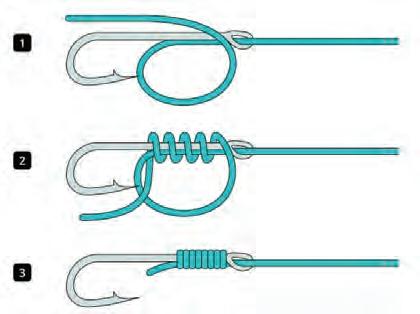
Thanks to hook eyes, this is no longer necessary, but a snell knot remains one of the best connections out there for simple line-to-hook connections. The knot’s ability to orient the point of the hook in the right direction for octopus and circle hooks makes it a go-to knot for live and cut bait fishing. You’ll get more solid hook sets when you snell circle hooks.
A snell knot is quick and easy to tie and it provides a strong connection. The only real disadvantage is the knot is on the shank of the hook, where it is vulnerable to the teeth of toothy critters. It’s probably not the best choice if you’re fishing for muskie or barracuda.

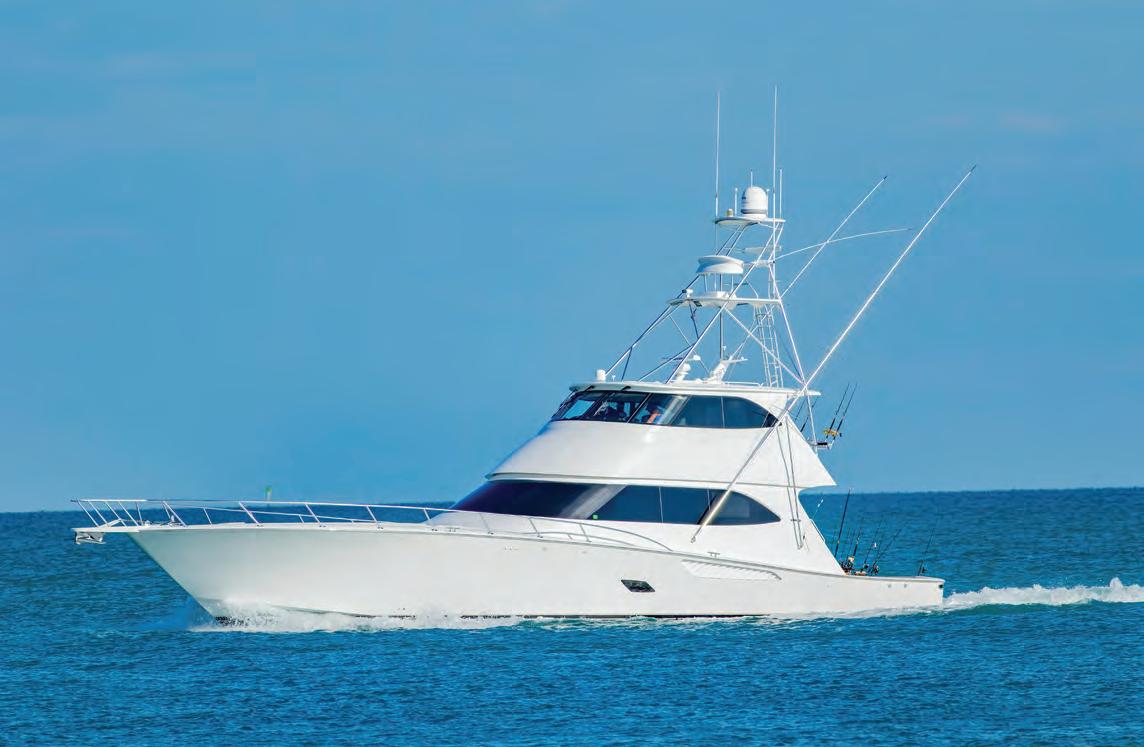
For more information, go to usangler.com.


This gorgeous Colorado River smallmouth bass is a new IGFA alltackle world length record for the species.
The chunky smallmouth measured 53 centimeters (20 inches) on an official IGFA measuring device, which tied the fish for the length record with two other officially recognized smallies. Sarah Harris landed her big fish while night fishing on the Colorado River in Arizona. It slammed a topwater lure and was boated after a short fight. After snapping some photos, Harris released it safely.

Harris’s bass tied a smallmouth caught by William Brent Evans from Alabama’s Lake Guntersville in 2014 as well as one caught from Washington’s Osoyoos Lake by Shane Hoelzle in 2020.
The IGFA all-tackle world record smallmouth by weight is a longstanding 11-pound, 15-ounce mark that was set in 1955 by David Hayes at Dale Hollow Lake in Tennessee.
Hayes’s Dale Hollow fish is a record that might stand forever, but those length records can be beaten. While a 20-inch smallmouth is definitely a trophy fish, 20-plus inchers are caught pretty regularly. It’s a matter of time before someone with an official IGFA measuring device puts one in the boat. For more, go to IGFA.org.

 TYLER WOOLCOTT
TYLER WOOLCOTT
This time of year, when bass are feeding up ahead of winter, it’s tough to beat a bladed jig—or Chatterbait—to find hungry fish.


In most cases, the Chatterbait is in my arsenal as a search bait to cover a ton of water. There isn’t a piece of cover that I can think of that I haven’t thrown it around with success. Docks, wood, grass, rocks, anywhere a bass might live and feed is a good place to throw it. Most of the time you can locate fish with this bait and then go back through the same area with something else and pick up some more bites. If there are hungry bass around and you present this bait in the right way, you will get a bite.
A lot of times I am trying to duplicate an injured baitfish with a Chatterbait, whether they be shad, shiners or bluegill. Whites, golds and green pumpkin colors are my go to baitfish imitators and are what I have tied on most of the time. If the water is dirty or when fish are feeding on crayfish, I’ll switch to a black and blue or even an orange or red color. Match a trailer bait of your choice on the back like a swimbait or a craw trailer, and you’ll be good to go.
Chatterbait bites are usually reaction strikes, so I vary the retrieve to create erratic action while keeping the lure in the strike zone. I do this by speeding up my retrieval speed and then pausing for a very short period of time and then resuming a normal retrieval rate. Believe it or not, there are way more fish that follow your bait and don’t commit than you think. A very small adjustment in the speed can make the difference and convince these fish to eat. A 3/8-oz. and a ½-oz. are pretty much the only two sizes I throw. This covers all different depth ranges from a foot of water down to 10 feet. Cover as much water as possible until you pin point a healthy population of feeding bass then slow down with a different bait that you can work slower.
Chatterbait Gear
A moderate-action rod makes a huge difference when it comes to keeping fish hooked up. The 13 Fishing Omen Black 7’4mhm is absolutely perfect for fishing a Chatterbait. I pair a 7:5:1 gear ratio Concept A 13 Fishing reel with this and spool it with 17-lb. Seaguar Abraz X. I throw some bigger line with this, as you are usually around some type of cover and are working the bait fairly fast, so they won’t get a chance to see your line anyway.
Hope this fishing tip will give you some confidence to try this technique, if you haven’t already. It flat out catches them. Good luck out there and tight lines!
Tyler Woolcott is a professional tournament angler and guide. Check out his website at www.tylerwoolcottfishing.com.









A20-pound mahi might not be surprising off the coasts of Florida or Mexico, but this 21-pound, 48-inch-long dolphinfish is a super rare catch off the coast of Washington State. It’s the largest one anyone’s ever caught there.
Angler Wade La Fontaine caught his state record mahi 42 miles out in the Pacific off the Washington coast on Aug. 25. He was on a charter trip with Capt. Keith Johnson aboard the Tunacious. They were trolling for tuna with plastic squid lures behind a spreader when the mahi hit.
Upon landing at the dock in Westport, Washington, the dolphinfish was checked by a Washington Department of Fish and Wildlife biologist, then weighed on a certified scale. After review, the record was certified on Aug. 30.
Dolphinfish are sporadically caught by recreational and commercial fishers targeting albacore tuna and other species off the Washington and Oregon coasts, including a handful recorded last year at the ports of Westport and Ilwaco and at least two this summer.
“Most mahi mahi caught off our coast are smaller fish in the 6- to 12-pound range,” read a WDFW press release. “La Fontaine’s fish — which was 48 inches long and 40 inches to the inside fork of the tail — was more reminiscent of large





dolphinfish caught in warmer waters off southern California, Mexico and Hawaii.”
The previous Washington state record weighed 16.27 pounds. It was caught by Albert DaSilva in 2013.
The charter reported 70-degree water temperature in the area where the fish was caught, which is warm, even for the warmer offshore currents, though not unprecedented especially during El Nino years, explained the release.


“I’m blessed beyond comprehension,” La Fontaine said. “I’ll be getting another tattoo of a mahi!”
Albacore tuna are the primary target for Pacific Northwest offshore anglers, with large schools of these “longfin tuna” abundant off the coast of northern California, Oregon, Washington, and British Columbia in the summer and early fall. Albacore are found in the blue water, a mass of warmer Sea Surface Temperature water typically found off the West Coast of North America during summer and fall, and off Southern California yearround.
For more information, go to https://wdfw.wa.gov/



